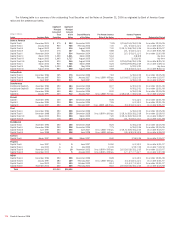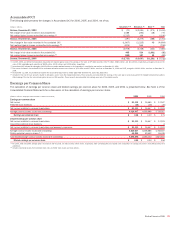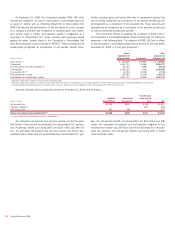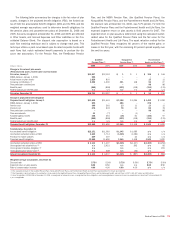Bank of America 2006 Annual Report Download - page 138
Download and view the complete annual report
Please find page 138 of the 2006 Bank of America annual report below. You can navigate through the pages in the report by either clicking on the pages listed below, or by using the keyword search tool below to find specific information within the annual report.Note 15 – Regulatory Requirements and
Restrictions
The Board of Governors of the Federal Reserve System (FRB) requires the
Corporation’s banking subsidiaries to maintain reserve balances based on
a percentage of certain deposits. Average daily reserve balances required
by the FRB were $5.6 billion and $6.4 billion for 2006 and 2005. Currency
and coin residing in branches and cash vaults (vault cash) are used to
partially satisfy the reserve requirement. The average daily reserve balan-
ces, in excess of vault cash, held with the FRB amounted to $27 million
and $361 million for 2006 and 2005.
The primary source of funds for cash distributions by the Corporation
to its shareholders is dividends received from its banking subsidiaries
Bank of America, N.A. and FIA Card Services, N.A. Effective June 10,
2006, MBNA America Bank, N.A. was renamed FIA Card Services, N.A.
Additionally, on October 20, 2006, Bank of America, N.A. (USA) merged
into FIA Card Services, N.A. In 2006, Bank of America Corporation
received $16.0 billion in dividends from its banking subsidiaries. In 2007,
Bank of America, N.A. and FIA Card Services, N.A. can declare and pay
dividends to Bank of America Corporation of $11.4 billion and $356 mil-
lion plus an additional amount equal to their net profits for 2007, as
defined by statute, up to the date of any such dividend declaration. The
other subsidiary national banks can initiate aggregate dividend payments
in 2007 of $68 million plus an additional amount equal to their net profits
for 2007, as defined by statute, up to the date of any such dividend decla-
ration. The amount of dividends that each subsidiary bank may declare in
a calendar year without approval by the Office of the Comptroller of the
Currency (OCC) is the subsidiary bank’s net profits for that year combined
with its net retained profits, as defined, for the preceding two years.
The FRB, the OCC and the Federal Deposit Insurance Corporation
(collectively, the Agencies) have issued regulatory capital guidelines for
U.S. banking organizations. Failure to meet the capital requirements can
initiate certain mandatory and discretionary actions by regulators that
could have a material effect on the Corporation’s financial statements. At
December 31, 2006, the Corporation, Bank of America, N.A. and FIA Card
Services, N.A. were classified as “well-capitalized” under this regulatory
framework. At December 31, 2005, the Corporation, Bank of America N.A.
and Bank of America, N.A. (USA) were also classified as “well-capitalized.”
There have been no conditions or events since December 31, 2006 that
management believes have changed the Corporation’s, Bank of America,
N.A.’s and FIA Card Services, N.A.’s capital classifications.
The regulatory capital guidelines measure capital in relation to the
credit and market risks of both on and off-balance sheet items using vari-
ous risk weights. Under the regulatory capital guidelines, Total Capital
consists of three tiers of capital. Tier 1 Capital includes Common Share-
holders’ Equity, Trust Securities, minority interests and qualifying Preferred
Stock, less Goodwill and other adjustments. Tier 2 Capital consists of
Preferred Stock not qualifying as Tier 1 Capital, mandatory convertible
debt, limited amounts of subordinated debt, other qualifying term debt, the
allowance for credit losses up to 1.25 percent of risk-weighted assets and
other adjustments. Tier 3 Capital includes subordinated debt that is
unsecured, fully paid, has an original maturity of at least two years, is not
redeemable before maturity without prior approval by the FRB and includes
a lock-in clause precluding payment of either interest or principal if the
payment would cause the issuing bank’s risk-based capital ratio to fall or
remain below the required minimum. Tier 3 Capital can only be used to
satisfy the Corporation’s market risk capital requirement and may not be
used to support its credit risk requirement. At December 31, 2006 and
2005, the Corporation had no subordinated debt that qualified as Tier 3
Capital.
Certain corporate sponsored trust companies which issue Trust
Securities are not consolidated under FIN 46R. As a result, the Trust
Securities are not included on our Consolidated Balance Sheet. On
March 1, 2005, the FRB issued Risk-Based Capital Standards: Trust Pre-
ferred Securities and the Definition of Capital (the Final Rule) which allows
Trust Securities to continue to qualify as Tier 1 Capital with revised quanti-
tative limits that would be effective after a five-year transition period. As a
result, Trust Securities are included in Tier 1 Capital.
The FRB’s Final Rule limits restricted core capital elements to 15
percent for internationally active bank holding companies. Internationally
active bank holding companies are those with consolidated assets greater
than $250 billion or on-balance sheet exposure greater than $10 billion. In
addition, the FRB revised the qualitative standards for capital instruments
included in regulatory capital. At December 31, 2006, our restricted core
capital elements comprised 17.3 percent of total core capital elements.
We expect to be fully compliant with the revised limits prior to the
implementation date of March 31, 2009.
To meet minimum, adequately-capitalized regulatory requirements, an
institution must maintain a Tier 1 Capital ratio of four percent and a Total
Capital ratio of eight percent. A well-capitalized institution must generally
maintain capital ratios 200 bps higher than the minimum guidelines. The
risk-based capital rules have been further supplemented by a leverage
ratio, defined as Tier 1 Capital divided by adjusted quarterly average Total
Assets, after certain adjustments. The leverage ratio guidelines establish
a minimum of three percent. Banking organizations must maintain a lever-
age capital ratio of at least five percent to be classified as “well-
capitalized.” As of December 31, 2006, the Corporation was classified as
“well-capitalized” for regulatory purposes, the highest classification.
Net Unrealized Gains (Losses) on AFS Debt Securities, Net Unreal-
ized Gains on AFS Marketable Equity Securities, Net Unrealized Gains
(Losses) on Derivatives, and the impact of SFAS 158 included in Share-
holders’ Equity at December 31, 2006 and 2005, are excluded from the
calculations of Tier 1 Capital and leverage ratios. The Total Capital ratio
excludes all of the above with the exception of up to 45 percent of Net
Unrealized Gains on AFS Marketable Equity Securities.
136
Bank of America 2006
























